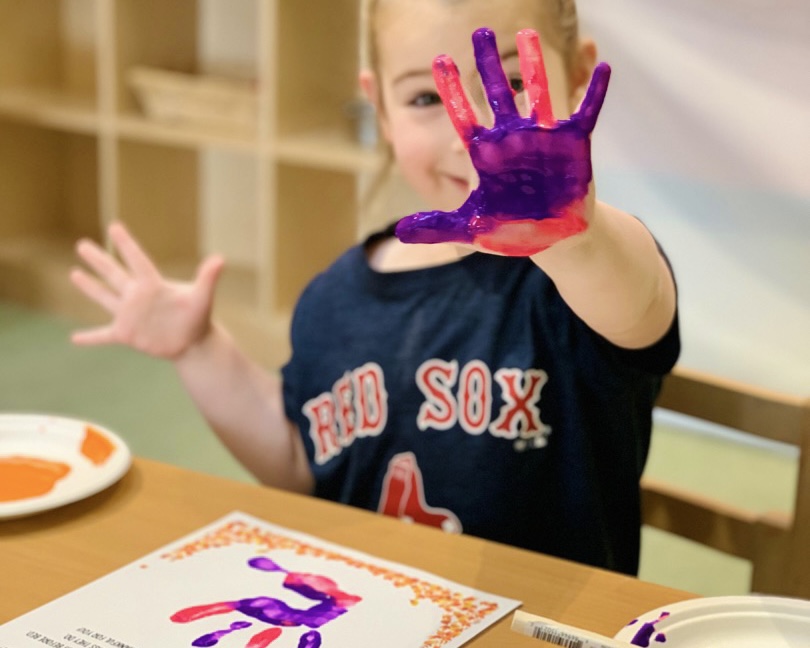“The ability to feel and express gratitude develops over time, but even young children are capable of learning this prosocial behavior and will do so in the presence of caring adults.”
What You’ll Learn
- What is gratitude and how is this practice beneficial for my child?
- How do I encourage my child to say “thank you”?
- How do I teach my child about gratitude throughout the year?
As we approach a season often associated with acts of kindness and gratitude, parents may face the question, “how do I raise a thankful child?”.
Parents want their children to be appreciative and practice this prosocial behavior independently, but here’s the thing: children can be taught to say thank you, but teaching children to be genuinely thankful requires an approach that emphasizes the meaning of the phrase “thank you,” paired with reflection and practice.
Read on to learn how to encourage your child to say thank you as a genuine expression of gratitude.
Gratitude: A Thankful Appreciation
Gratitude is not only about learning how and when to say “thank you” to others. Gratitude is a reflective process and a thankful appreciation for what we receive in life, tangible or intangible. Gratitude has four components:
1. Noticing: Recognizing what you have to be grateful for.
2. Thinking: Reflecting on why you have those things.
3. Feeling: Experiencing emotions as a result of receiving something.
4. Doing: Expressing your appreciation.
Gratitude is a practice to incorporate into our everyday lives, not just around the holidays. Practicing gratitude leads to significant benefits for our psychological well-being and physical health. Research suggests that gratitude is strongly and consistently associated with increased positive emotions, more optimistic perspectives, stronger relationships, better sleep, and increased motivation.
Teaching and Encouraging Gratitude
The ability to feel and express gratitude develops over time, but even young children are capable of learning this prosocial behavior and will do so in the presence of caring adults. Here are some suggestions for how to encourage and practice gratitude with your child:
- Discuss and read about gratitude.
- Explain why we say thank you and how showing gratitude makes ourselves and other people feel. This conversation will help your child understand how their behaviors affect others and the emotional benefits of saying thank you.
- Try this: Share personal stories of gratitude and read books about people practicing generosity and gratitude. Here are some books to consider:
- Grateful: A Song of Giving Thanks by John Bucchino
- We Are Grateful by Traci Sorell
- Thankful by Elaine Vickers
- Apple Cake: A Gratitude by Dawn Casey
- Gracias-Thanks by Pat Mora
- My Heart Fills with Happiness by Monique Gray Smith
- Thank You, Day by Charlie Hopper
- Good People Everywhere by Lynea Gillen
- The Thankful Book by Todd Parr
- Thank You, Omu by Oge Mora
- Model how you express gratitude.
- Children learn by watching the adults in their lives. You can demonstrate what it means to be grateful by offering a genuine “thank you” to your child and the people around you.
- Try this: Ask your child to help with simple chores around the house, like putting away toys, and thank them for doing these helpful tasks. This will let your child know that they are appreciated. You can also make sure to point out times when your child shows gratitude independently—“I really liked the way you said thank you to your friend when they shared with you. How did that make you feel?”
- Incorporate gratitude into your daily routine.
- Talk about gratitude and reflect on what you are grateful for out loud, every day.
- Try this: At dinner or bedtime, ask your child to think of three things they are grateful for. You can also make this into a game where each person in the family takes a turn saying what they are grateful for, beginning with “I am grateful for…” or “I love…”.
- Try this: Create a family gratitude board to show what each family member is grateful for. This board could include written notes, drawings, or pictures.
- Practice alternative ways to express gratitude.
- Not everyone expresses gratitude in the same way, and it’s okay to practice different forms of communication.
- Try this: Ask your child what feels comfortable for them to express their gratitude and practice it with them. This could include a smile or thumbs up, writing or drawing a thank you note, or using sign language.
All children have the potential to become generous, compassionate, and thankful individuals. While you encourage this gratitude at home, here is a thank you from me—thank you for being a thriving parent and helping your child become an individual this world needs. Your efforts are seen and you are appreciated.
Empowering Takeaways
- Teaching young children how to genuinely apologize is possible through reflection and practice.
- Gratitude is more than saying “thank you,” and this practice is associated with long-term benefits.
- Varied experiences are necessary to learn about the true meaning of gratitude.
Be vibrant and keep thriving!
This article was last reviewed or updated on November 25, 2023.
References
Child Mind Institute. (2023, October 30). 10 tips for raising grateful kids: How to help kids show (and feel) appreciation). https://childmind.org/article/10-tips-raising-grateful-kids/
Harvard Medical School. (2023). Giving thanks can make you happier. Harvard Health Publishing. https://www.health.harvard.edu/healthbeat/giving-thanks-can-make-you-happier.
Kosmos, L. (2017, September 29). I stopped forcing my kids to say thank you, and they learned true gratitude. The Washington Post. https://www.washingtonpost.com/news/parenting/wp/2017/09/29/i-stopped-forcing-my-kids-to-say-thank-you-and-they-learned-true-gratitude/
Kris, D. F. (2016, August 22). Raising grateful kids: Why giving thanks is good for the soul. PBS Kids. https://www.pbs.org/parents/thrive/raising-grateful-kids-why-giving-thanks-is-good-for-the-soul
Morin, A. (2020, November 11). How to teach children gratitude. Verywell Mind. https://www.verywellmind.com/how-to-teach-children-gratitude-4782154
Riess, J. A. (n.d.). Raising a thankful child. National Association for the Education of Young Children. https://www.naeyc.org/our-work/families/raising-thankful-child
UCLA Health. (2023, May 22). Health benefits of gratitude. https://www.uclahealth.org/news/health-benefits-gratitude#:~:text=Research%20shows%20that%20practicing%20gratitude,positively%20affect%20your%20physical%20health.



